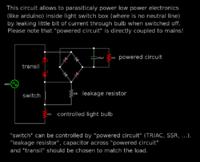harvie
Full Member level 1
Hello, you may be familiar with the situation. You have old light wiring in your house, so there's one live wire and one wire going to lightbulb. And you want to roll your own smart switch connected to wifi or controlled by remote control. So you obviously miss the neutral wire and try hard to overcome this problem.
i've came with this:

Falstad circuit simulator code:
https://github.com/Harvie/Designs/blob/master/electronics/parasitic_switch.circuit
It's surely not the best way to power light switching electronics. What do you think about it? Will it work? Is there any room for improvement? What about fluorescent bulbs, LED bulbs, etc? How do you solve this problem?
i've came with this:

Falstad circuit simulator code:
https://github.com/Harvie/Designs/blob/master/electronics/parasitic_switch.circuit
It's surely not the best way to power light switching electronics. What do you think about it? Will it work? Is there any room for improvement? What about fluorescent bulbs, LED bulbs, etc? How do you solve this problem?
Last edited by a moderator: